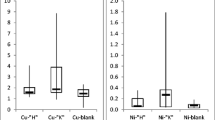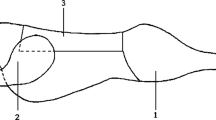Abstract
Copper content in muscle and the presence of bullet fragments were assessed in samples from red deer (Cervus elaphus), roe deer (Capreolus capreolus), fallow deer (Dama dama) and wild boar (Sus scrofa) (total of 46 animals) which had been hunted with two types of solid copper bullets. Also, the release of copper from bullets or fragments remaining in muscle was tested. For bullet type “B”, a fragment was detected in only 1 out of 34 carcasses whereas for type “A”, fragments were detected in all 12 carcasses, with up to 24 fragments (maximum size, 5 × 7 × 2 mm). Median copper concentrations around the shot wound (0–30 mm distance) were 1.25 and 1.77 mg/kg fresh weight for bullet types B and A, respectively, and thus in the expected range for venison. Around bullet fragments that had remained in muscles, the copper content increased significantly. In roe deer longissimus muscle that had been exposed for 7 days at +7 °C to bullets of type B, up to 1,000 mg/kg copper (fresh weight) was found in a distance of 0–2 mm. However, in a distance of 10–20 mm, maximum copper contents were <10 mg/kg fresh weight. Bullet fragments can constitute physical hazards and will release copper under acidic conditions as those prevailing in meat. Removal of bullet fragments prior to culinary preparation should ensure that a recommended dietary copper intake of 1.25 mg per adult consumer per day is not exceeded. From a food hygiene viewpoint, non-fragmenting bullets seem to be preferable.


Similar content being viewed by others
References
Anonymous (2012a) Material safety data sheet. At: http://www.barnesbullets.com/wp-content/uploads/2010/12/Barnes-TSX-TTSX-XPB-MZ-TMZ-T-EZ-TAC-X-TAC-TX-TAC-XPLRX-SGS-Bullets-MSDS.pdf. Accessed 12 April 2012
Anonymous (2012b) Aero Preisliste 2011. At: http://up.picr.de/6520468kjh.pdf. Accessed 12 April 2012
Astrup T, Boddum JK, Christensen TH (1999) Lead distribution and mobility in a soil embankment used as a bullet stop at a shooting range. J Soil Contam 8(6):653–665
Avery D, Watson RT (2009) Regulation of lead-based ammunition around the world. In: Watson RT, Fuller M, Pokras M, Hunt WG (eds) Ingestion of lead from spent ammunition: implications for wildlife and humans. The Peregrine Fund, Boise. doi:10.4080/ilsa.2009.0115
Bundesinstitut für Risikobewertung (2010) Bleibelastung von Wildbret durch Verwendung von Bleimunition bei der Jagd. Stellungnahme Nr. 040/2011 des BfR vom 3. Dezember 2010. http://www.bfr.bund.de/cm/343/bleibelastung-von-wildbret-durch-verwendung-von-bleimunition-bei-der-jagd.pdf. Accessed 12 March 2012
Dobrowolska A, Melosik M (2008) Bullet-derived lead in tissues of the wild boar (Sus scrofa) and red deer (Cervus elaphus). Eur J Wildl Res 54:231–235
DGE-Deutsche Gesellschaft für Ernährung (2000) Konzeption und Entwicklung: Arbeitsgruppe “Referenzwerte für die Nährstoffzufuhr” (DGE, ÖGE, SGE, SVE, Eds.), 1st edn. Umschau/Braus, Frankfurt am Main, pp 201–202
Fisher IJ, Pain DJ, Thomas VG (2006) A review of lead poisoning from ammunition sources in terrestrial birds. Biol Conserv 131:421–432
Franson CJ, Lahner LL, Meteyer CU, Rattner BA (2012) Copper pellets simulating oral exposure to copper ammunition: absence of toxicity in American kestrels (Falco sparverius). Arch Environ Contam Toxicol 62:145–153
Friend M, Franson JC, Anderson WL (2009) Biological and societal dimensions of lead poisoning in birds in the USA. Ingestion of lead from spent ammunition: implications for wildlife and humans. The Peregrine Fund, Boise. doi:10.4080/ilsa.2009.0104
Goldman DP (2002) The Physical Hazards of Foreign Materials. At: http://www.fsis.usda.gov/OPPDE/rdad/FRPubs/02-033N/ThePhysicalHazardsofForeignMaterials.pdf. Accessed 18 March 2012
Hecht H (2000) Auswirkung der Geschosswahl auf die Bleibelastung des Wildbrets Tagung für die Jägerschaft. Tagung für die Jägerschaft 2000, BAL Gumpenstein:19–22
Hunt WG, Burnham W, Parish CN, Burnham KK, Mutch B, Oaks JL (2006) Bullet fragments in deer remains: implications for lead exposure in avian scavengers. Wildl Soc Bull 34:167–170
Hunt WG, Watson RT, Oaks JL, Parish CN, Burnham KK, Tucker RL, Belthoff JR, Hart G, Zhang B (2009) Lead bullet fragments in venison from rifle-killed deer: potential for human dietary exposure. PLoS One 4(4):1–6. doi:10.1371/journal.pone.0005330
Hunter TB, Taljanovic MS (2003) Foreign bodies. Radiographics 23(3):731–757. doi:10.1148/rg.233025137
IRMM (2012) Certified Reference Materials 2012. IRMM, Geel
Kenntner N, Crettenand Y, Fünfstück HJ, Janovsky M, Tataruch F (2007) Lead poisoning and heavy metal exposure of golden eagles (Aquila chrysaetos) from the European Alps. J Ornithol 148:173–177
Knott J, Gilbert J, Green RE, Hoccom DG (2009) Comparison of the lethality of lead and copper bullets in deer control operations to reduce incidental lead poisoning; field trials in England and Scotland. Conservation Evidence 6:71–78
Knott J, Gilbert J, Hoccom DG, Green RE (2010) Implications for wildlife and humans of dietary exposure to lead from fragments of lead rifle bullets in deer shot in the UK. Sci Total Environ 409:95–99
Krone O, Trinogga AL (2008) Die Ursachen der Bleivergiftung beim Seeadler und röntgenologische Untersuchungen zum zielballistischen Verhalten bleihaltiger und bleifreier Jagdgeschosse. ÖKO Jagd 3:6–9
Krone O, Kenntner N, Trinogga A, Nadjafzadeh M, Scholz F, Sulawa J, Totschek K, Schuck-Wersig P, Zieschank R (2009) Lead poisoning in whitetailed sea eagles: causes and approaches to solutions in Germany. Ingestion of lead from spent ammunition: implications for wildlife and humans. The Peregrine Fund, Boise. doi:10.4080/ilsa.2009.0207
Lawrie RA, Ledward DA (2006) Lawrie's meat science. Woodhead Publishing Limited, Cambridge
Lozan JL, Kausch A (1998) Angewandte Statistik für Naturwissenschaftler, 2nd edn. Blackwell, Wien, p 44, pp. 134–137
Mateo R, Rodriguez-de la Cruz M, Vidal D, Reglero M, Camarero P (2007) Transfer of lead from shot pellets to game meat during cooking. Sci Total Environ 372:480–485
Mateo R, Baos AR, Vidal D, Camarero PR, Martinez-Haro M, Taggart MA (2011) Bioaccessibility of Pb from ammunition in game meat is affected by cooking treatments. PLoS One 6:e15892
Olsen AR (1998) Regulatory action criteria for filth and other extraneous materials I. Review of hard or sharp foreign objects as physical hazards in food. Regul Toxicol Pharmacol 28:181–189. doi:10.1006/rtph.1998.1249
Pschill W, Winkelmayer R (2006) Alles vom Wild. Österreichischer Jagd- u. Fischerei Verlag, Vienna
Sachs L (1974) Angewandte Statistik, 7th edn. Springer, Berlin, pp 238–240
Sager M (2005) Aktuelle Elementgehalte in Fleisch, Leber und Nieren aus Österreich. Ernährung 29(5):199–206
Sager M, Grüner M, Würzner H (1998) Gehalte ausgewählter Spurenelemente in Leber und Nieren von Nutztieren. Die Bodenkultur 49(2):109–117
Solich S (2007) Wild gekocht. Österreichischer Agrarverlag Druck- u. Verlagsges m.b.H, Vienna
Acknowledgments
The study was supported by the “Österreichische Bundesforste AG” and the “Verein Grünes Kreuz”, Vienna, Austria. Preliminary findings have been presented in the “Rundschau für Fleischhygiene und Lebensmittelüberwachung” 64:62–64. Animals were obtained from regular hunts.
Author information
Authors and Affiliations
Corresponding author
Additional information
Communicated by C. Gortazar
Rights and permissions
About this article
Cite this article
Irschik, I., Bauer, F., Sager, M. et al. Copper residues in meat from wild artiodactyls hunted with two types of rifle bullets manufactured from copper. Eur J Wildl Res 59, 129–136 (2013). https://doi.org/10.1007/s10344-012-0656-9
Received:
Revised:
Accepted:
Published:
Issue Date:
DOI: https://doi.org/10.1007/s10344-012-0656-9




